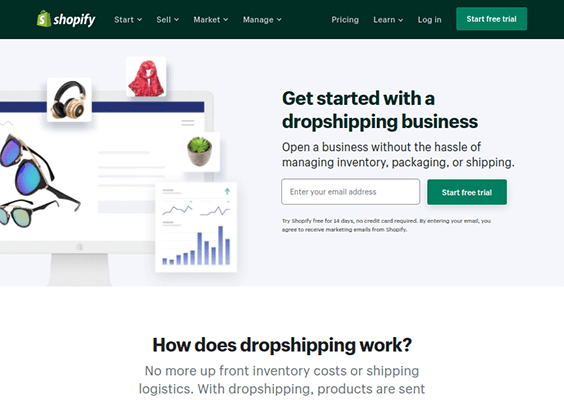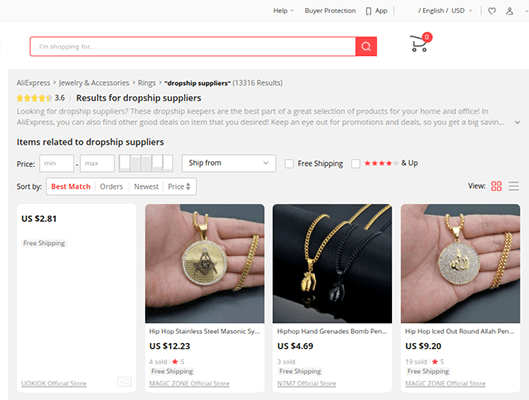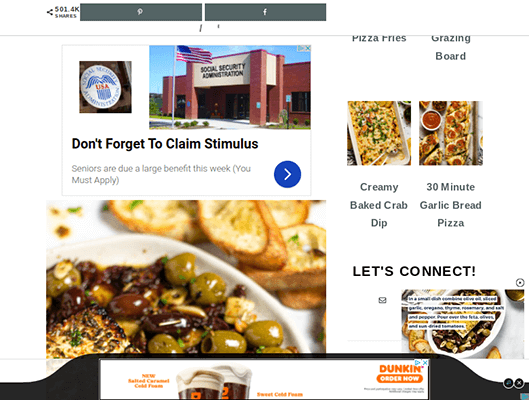What Is Affiliate Marketing? And Is It Worth It In 2024?

Is affiliate marketing worth it?
That’s the question we’re going to cover in this post.
Affiliate marketing has been a common source of revenue for online businesses for as long as online business has been a thing.
It’s even common among social media influencers these days.
That’s why we want to know: what is affiliate marketing, and is it still profitable?
What is affiliate marketing?
Affiliate marketing is a form of advertising in which a business pays marketers, known as affiliates, to promote their products or services.
It’s one of the most popular revenue streams for blogs, podcasts, YouTube channels and social media influencers.
That’s because it’s one of the easiest ways to monetize a blog or media-based entity.
It doesn’t require any money to get started, and you can generate revenue with a small audience.
How does affiliate marketing work?
Affiliate marketing works like this: a company launches an affiliate marketing program or adds their products/services to an affiliate network.
An affiliate network acts as a middleman between a business and an affiliate.

Basically, an affiliate marketer must join the affiliate network the business is part of. They’re free to create affiliate links for that business and any other business that’s part of the network once they do.
Whether a business runs their own affiliate program or uses an affiliate network, the next step involves marketers joining the program to become affiliates.
Each affiliate receives their very own affiliate link in the form of a URL parameter appended to the end of the URL for the product page they want to promote.
Check out our affiliate link for Blogging Wizard’s web host Cloudways, which provides a free $10 credit on your first month.

If you look at the end of the affiliate link, you’ll notice our unique affiliate ID located after the question mark “?id=”
A business pays an affiliate a commission (a percentage of the total sale) when an internet visitor clicks an affiliate link for a product then purchases that product.
The unique affiliate ID lets the company’s affiliate system know which affiliate referred the customer. Each completed affiliate sale is called a “referral” for this reason.
Does affiliate marketing benefit the businesses that run these programs? Absolutely!
According to reports by Cheq and Kick Start Your Own Affiliate Marketing Business by Joy Renkins, affiliate marketing spend generated by the affiliate marketing industry amounts to over $6.8 billion in the United States, and affiliate marketers generate between 5 and 25% of sales for businesses.
That’s affiliate marketing in a nutshell, but how do you start your own affiliate business? And is affiliate marketing worth it?
How to start a successful affiliate marketing business
You’ll need the following in order to start your own affiliate marketing business:
- Affiliate marketing niche
- Affiliate products to sell
- A place to promote affiliate links
If you already have a blog, YouTube channel, podcast or popular Instagram/TikTok account, you’re already on the right track.
You just need to join affiliate programs that suit your niche.
Otherwise, research the best affiliate platforms and programs to join.
Coincide this with research on the niches each platform and program belong to. You want to choose an affiliate niche that has a lot of search potential.
This will give you the best chance at creating content that’ll bring in a lot of traffic to your affiliate pages.
Different ways affiliate programs pay affiliates
All affiliates are paid on commission. How much that commission is and how often you receive it is dependent on the program you join.
Most affiliate programs pay commissions at a certain percentage on a one-time basis, such as a 20% commission for each sale you generate.

Some subscription-based programs pay for as long as the customer you refer keeps their subscription active.
So, if a company pays a 20% recurring commission, and a customer you refer keeps their subscription active in June, July and August, you’ll receive 20% of what they pay for each of those months.
Some companies pay a flat-fee as a commission rate rather than a percentage.
Others pay a commission fee for new signups, then pay an additional fee when those signups turn into new subscriptions.

Most companies distribute affiliate payouts through PayPal 30 days after each referral is made.
Some will distribute direct deposits or wire transfers to your bank account.
Is affiliate marketing worth it?
Before you jump into this new business venture, you’re probably wondering a few things: is affiliate marketing worth the effort, and is affiliate marketing still profitable?
The short answer is yes, affiliate marketing is still profitable.
When you pick the right niche as well as the right affiliate programs, you can indeed make a profit.
The real answer is a little more complicated than that, so we’re going to break it down into a few different topics:
- Is affiliate marketing still profitable?
- The pros and cons of affiliate marketing.
- Alternatives to affiliate marketing and how they compare.
Is affiliate marketing still profitable?
Here’s what you need to make a profit with affiliate marketing:
- An engaged audience.
- A quality affiliate product to promote.
- High-quality content to promote that affiliate product.
To break this down even further, you need to start by creating content people care about.
You also need to find ways to encourage your audience to engage with your content. If they’re not engaged, they’re not going to click your affiliate links.
Lastly, don’t just choose the product that pays the highest commission. You want to promote an affiliate product you know your audience loves.
Avoid products that have negative reviews or companies that receive too much negative press.
Get to know your audience and niche instead. It’ll be easy to determine which products to affiliate yourself with when you do.
How much do affiliate marketers make?
Let’s talk real numbers. Here are a few affiliate earnings in income reports from blogs in different niches.
Low earners and high earners are included to demonstrate the diversity in the revenue an affiliate marketer may make.
Each dollar amount was earned in the month referenced in parentheses.
You should also note that high-earning income reports are hard to find these days, but it doesn’t mean that blogs aren’t earning a lot of money from affiliate marketing.
It’s a common trend for blogs to stop reporting their income when they start making six-figures per month regularly.
- It’s a Lovely Life (August 2019, most recent report)
- Affiliate Revenue: $103,720.49
- Total Revenue: $222,857
- This Online World (2021 as a whole)
- Affiliate Revenue: $30,806.48
- Total Revenue: $92,614.42
- Just a Girl and Her Blog (December 2016, most recent report)
- Affiliate Revenue: $27,507
- Total Revenue: $41,700
- One Hour Professor (January 2022)
- Affiliate Revenue: $11,234
- Total Revenue: $31,123
- CarlBroadbent (January 2022)
- Affiliate Revenue: $6,935.91
- Total Revenue: $10,637.61
- Sadie Smiley (February 2022)
- Affiliate Revenue: $2,520.63
- Total Revenue: $17,521
- Fork in the Road (January 2022)
- Affiliate Revenue: $986.16
- Total Revenue: $3,148.45

Who is the most successful affiliate marketer ever?
This is hard to say as many affiliate marketers stop reporting their earnings as they get higher and higher (into six figures and beyond).
However, successful affiliate marketer Jason Stone, known as the Millionaire Mentor, claims to have generated over $7 million in sales in just 18 months at one point.
The pros and cons of affiliate marketing
PRO: It’s easy to get started
Many affiliate programs don’t require you to have a certain number of monthly visitors or followers before you join.
Many also don’t have a quota you’re expected to reach over a certain period in order to remain a part of the program.
This means anyone can get started with affiliate marketing. You just need a place to create content (for promoting affiliate links).
You don’t need a massive audience to get going.
PRO: Create multiple revenue streams
You’ve heard the phrase “don’t keep all your eggs in one basket.”
The reason is simple. If something happens to that basket, you lose each and every one of your eggs in one fell swoop.
This is what can happen to your blog’s income stream if you earn all of your income from a single source.
This is why affiliate marketing is such a great source of revenue. Every affiliate program you join is another revenue stream for your blog.
PRO: It’s cheap!
Affiliate programs are free to join, and you don’t need to purchase the products you promote in order to generate affiliate sales.
Sure, creating a detailed review or tutorial with the product in hand makes for more unique content, but plenty of affiliate marketers get by without it.
Plus, many affiliate marketers get by with a YouTube channel, Instagram account or TikTok account alone, which are free to run so long as you have a phone to record videos.
PRO: Certain strategies generate passive income
The problem with using social media platforms like Instagram and TikTok to promote affiliate links is the way these platforms operate.
Their algorithms are designed to show recent posts. Older posts are rarely seen.
This means you’ll need to put out new content constantly in order to keep generating affiliate income.
Blogs and YouTube channels, on the other hand, have the unique ability to host evergreen content.
With evergreen content, you can create blog posts that rank high in search engines for years to come.
If you insert affiliate links into these posts, you can generate a stream of passive income for as long as these posts rank.
CON: Affiliate marketing is unstable
This is the biggest disadvantage of affiliate marketing.
There’s a lot of instability in earning money through marketing products that are not your own.
For starters, businesses are free to do whatever they please with their affiliate programs.
This includes changing commission rates and discontinuing programs all together.
This is what happened in 2020 when Amazon made major changes to their affiliate program Amazon Associates.
Amazon pays different commission rates for different retail categories. They wound up slashing rates for multiple categories, some by over 50%.

Today, the highest commission rates you can make from Amazon Associates are products sold under the Amazon Games, Luxury Beauty, Luxury Stores Beauty and Amazon Explore categories.
These products earn 10 or 20% commissions.
All other categories earn 6% or less, which are abysmal rates from a company that generates hundreds of billions of dollars per annum.
Aside from that, you also have no control over the reputations of the companies whose products you promote nor do you have control over their products.
This is why it’s so important for affiliate marketers to join multiple programs.
CON: It’s time consuming
Affiliate marketing may not cost a lot of money, but it sure does eat up a lot of time.
This is due to the content creation process required for affiliate marketing.
If you promote affiliate links through Instagram, TikTok or your podcast, you’ll need to create new posts, stories and episodes regularly.
You can create evergreen affiliate pages on your blog, but it’ll take a lot of time and effort to get your blog to a point where it’s receiving enough organic traffic.
CON: Skeptics exist
This is less of a concern as other disadvantages of affiliate marketing, but it’s still something you should be aware of.
Some internet users are skeptical of blog and social media posts that contain an “affiliate disclosure” or “#ad.”
Some may even go as far as accusing you of being paid to write positive reviews or deliberately ignoring a product’s faults in order to drive affiliate sales.
This is why it’s best to only promote proven products you trust.
Trolls, haters and naysayers exist in every corner of the internet. As long as you’re confident that you’ve chosen to affiliate yourself with the best products in your niche, the bulk of your audience will feel this way as well.
Alternatives to affiliate marketing
There are alternatives to affiliate marketing in case you don’t want to use it as a revenue stream or you want to diversify your income stream.
We’re going to cover three alternatives and how they compare to affiliate marketing:
- Sponsorships
- Dropshipping
- Advertising
Sponsorships vs affiliate marketing
Sponsorships are personalized deals you make with companies you promote.
In affiliate marketing, a business only pays you when you help them generate sales.
When a business sponsors you, they pay upfront. You’re then obligated to promote them in your content.
Most sponsors also prefer to choose how you promote them, often requiring you to send blog posts and videos to them for approval before they go live.
It’s up to you to negotiate how much you want to charge for sponsorships, so you’ll make more money through a single sponsorship deal than you would a single affiliate sale.

However, finding businesses to sponsor you can be tough, especially when you’re new.
Because they’re spending more, businesses prefer for you to have a much larger audience than they require for affiliate marketing programs.
Even so, adding sponsorships to your income stream is a great way to increase the amount of revenue you bring into your online business.
Dropshipping vs affiliate marketing
Dropshipping is another way to sell products that are not your own.
Basically, you create an online store with an ecommerce platform that supports dropshipping, such as Shopify or BigCommerce.

The major difference between a dropshipping store and a regular ecommerce store is where your products are sourced from.
With dropshipping, your products are hosted by a service like AliExpress. The prices you see in this marketplace are the prices you’ll pay for each product sold in your store.
You sell the products at a higher price to make a profit. They’re shipped by the dropshipping supplier themselves when customers complete orders in your store.

You only pay the dropshipper when a customer completes an order, so you don’t need to pay for wholesale products upfront as you would a traditional store.
Dropshipping is a legitimate way to make money online, but it can be a lot harder to make a buck than it is with affiliate marketing.
Plus, if you don’t want to pay for ads, you’ll need to use much of the same marketing strategies as you would for affiliate marketing, anyway.
Learn more in our article on dropshipping pros and cons.
Advertising vs affiliate marketing
Advertising can actually be a lucrative way to monetize a blog when you join the right ad network.
This mainly means avoiding Google AdSense and using another ad network instead.

Some of the best ad networks for bloggers include Media.net, Monumetric and AdThrive.
In fact, here are AdThrive earnings reports from two food bloggers:
- Pinch of Yum (November 2016)
- AdThrive Income: $52,313.13
- Total Income: $95,197.34
- Midwest Foodie Blog (March 2022)
- AdThrive Income: $18,100
- Total Income: $22,571
When you use the right ad network, you may find it easier to generate income from advertising than affiliate marketing as you’ll generate ad revenue from any page that receives visits.
The only downsides are the way ads can affect your site’s performance and appearance.
Is affiliate marketing worth it? — The final verdict
So, is an affiliate marketing business still worth it? Yes, if you’re willing to put in the work!
All you need is an audience, quality affiliate products to promote and content that drives traffic.
That’s all easier said than done, but it’s definitely possible if you’re willing to take the time to do it.
Again, if passive income is what you’re after as an affiliate marketer, a blog is the best way to create evergreen content for affiliate pages.
Check out our guide on How To Start A Blog for a step-by-step tutorial on how to get a new blog up and running today.
It covers all the bases, including:
- Choosing a profitable niche.
- Registering a domain.
- Getting a website up and running with WordPress.
- Choosing a WordPress theme.
- Configuring your WordPress site.
- Creating your first pages.
- Tips on how to blog.
- Strategies for growing and monetizing your blog.
Related reading:
Disclosure: Our content is reader-supported. If you click on certain links we may make a commission.
